Wow, what a field season! Do we feel like that every year at VCE? Well, yes, but this year definitely brought exciting progress on many of our projects, both old and new.
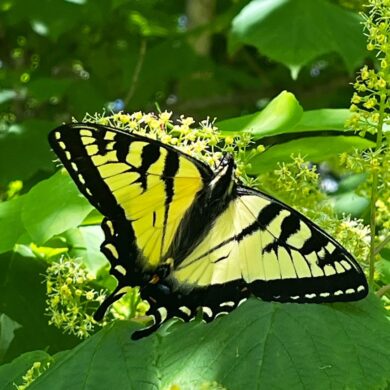
Canadian Tiger Swallowtail (Papilio canadensis) © Rachel McKimmy
This year marked the second year of the Second Vermont Butterfly Atlas, a five-year survey which aims to understand long-term trends in butterfly population distribution and abundance. The first Vermont Butterfly Atlas ran from 2002-2007, and now, 20 years later, Vermont is poised to be the first state or provincial atlas to do a second. The data collected from this project provides a rare opportunity to understand long-term trends in butterfly populations and provide essential information for environmental management and policy. As of November 2024, 132 observers have recorded 14,037 observations of 101 species and will continue to survey for the Atlas through 2027. To explore observations and join the project, visit the project page on e-Butterfly.
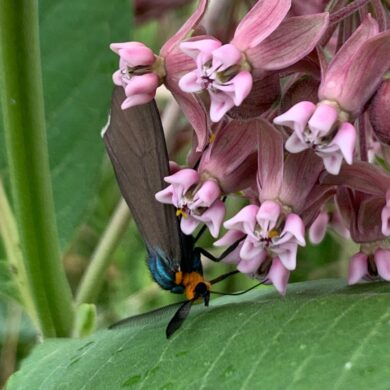
Virginia Ctenucha Moth (Ctenucha virginiana) on Common Milkweed (Asclepias syriaca). © Gita Yingling
iNaturalist is a rich source of information, showing where plants, animals, and other living things can be found. It can also collect data on interactions between species at larger spatial and temporal scales than ever before. Early last year, we launched a new project studying plant-insect interactions across the Northeast—the Pollinator Interactions on Plants project, or ‘PIP’ for short. This project aims to synthesize observations of insects visiting flowers from field studies, published literature, and community-collected observations. As of this November, 9,774 observers have recorded 162,982 observations of 2,094 species! To view observations and join the project, visit the project page on iNaturalist. You can also submit your observations of caterpillars on host plants by joining this iNaturalist project.
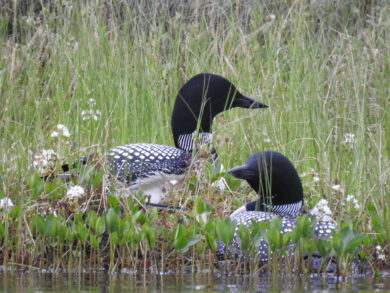
Pair of Common Loons. © Abby Reifsnyder
Our Loon Conservation Project continued to provide valuable insights into the health of Vermont’s loon population. In total, we identified 123 Common Loon nesting pairs, 85 of which successfully hatched 125 chicks! The number of nesting pairs continues to rise from 2021 through this year, with 11 new nesting pairs identified this summer. This year saw a decline in chick survival rates, with 81 out of 125 chicks (65%) surviving through August, compared to the average chick survival rate from 2004 to 2023 (76%). But not to worry, Vermont’s loon population is still stable and growing. This field season, more than 350 volunteers helped to monitor Vermont’s loons with assistance from Vermont Fish and Wildlife Department game wardens—thank you to everyone who participated! Read the full 2024 Loon Season Summary on our blog.
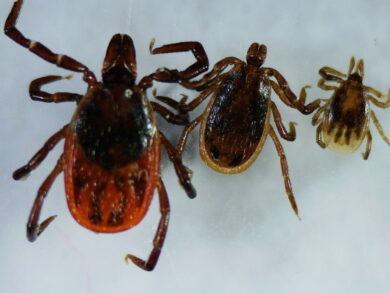
Photo of Black-legged Ticks (Ixodes scapularis). From left to right, adult female, adult male, and nymph.
This summer, our Upper Valley Tick Project crawled back to gather more data that will help landowners make informed pest management decisions. The goal of this project is to understand if commercially applied tick chemical control measures have unintended consequences for beneficial insect communities and pollinators. Thanks to the hard work of technicians Amber Jones, Juno Stahl, and others, we surveyed 135 properties throughout the Upper Valley, including 67 properties that were sprayed with pesticides for tick control. We walked more than 31 miles of transects across folks’ lawns, finding 248 ticks; 79% were Black-legged Ticks (Ixodes scapularis, also known as deer ticks). We also used beatsheets to sample 3614 shrubs and trees, identifying more than 17,000 non-tick invertebrates (e.g., spiders, beetles, and true bugs) to understand if they are also impacted by the pesticide application. This was the second, and final year of the study, and we will be writing up the results for publication over the winter months.
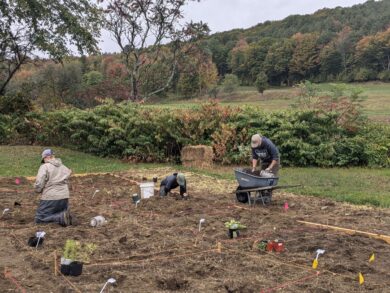
VCE and volunteers planting at Sunrise Farm.
This year also saw VCE scientists collaborating with the Native Plant Trust to install a new common garden experiment to study how the geographic source of native seed (called plant provenance) influences plant resilience, traits, and pollinator support. In September of this year, 1,080 plants were planted in six public gardens in the Upper Valley of VT and NH. You can find these gardens at VINS, Billings Farm & Museum, Cedar Circle Farm, Dartmouth Farm, Sunrise Farm, and the Hartland Library. We are grateful to the volunteers who came out to help us with our plantings! In 2025, once the plants are established, we will begin our data collection on these plants to see how well they grow, how much they flower and which insects visit them. To learn more about the Vermont Plant Provenance Experiment, visit the project page and read more on our blog.
To read about this season on Mount Mansfield and Mount Washington, check out the Mount Mansfield End of Season blog by Seasonal Bird Bander, Anna Peel.
And if you haven’t already, read the newest update on Mountain Birdwatch and the 2024 State of the Mountain Birds Report by Conservation Biologist Jason Hill.
This article only scratches the surface of all of the projects that VCE currently has in the works and all of the hard work that our staff and volunteers put in during the field season. To stay up-to-date on all things VCE, consider subscribing to our eNews letter (if you’re not already).

Thank you for your incredibly important work. What you are doing and all that you are accomplishing is phenomenally impressive!! I live in Thomaston, Maine. Thank you.
Keep up the great work!!